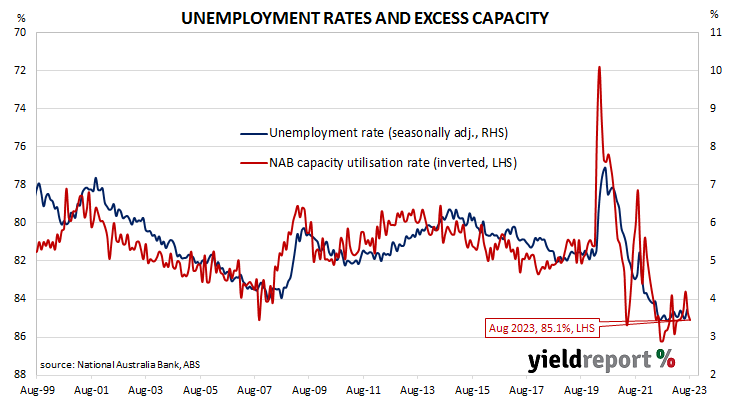Summary: Business conditions improve in August; business less pessimistic, still below average; broad-based uptick in conditions across most industries; deep negatives in the retail sector; ANZ: continued strength in business community, inflation may prove hard to quash; capacity utilisation rate rises, at elevated level.
NAB’s business survey indicated Australian business conditions were robust in the first half of 2018, with a cyclical-peak reached in April of that year. Readings from NAB’s index then began to slip and forecasts of a slowdown in the domestic economy began to emerge in the first half of 2019 as the index trended lower. It hit a nadir in April 2020 as pandemic restrictions were introduced but then conditions improved markedly over the next twelve months.
According to NAB’s latest monthly business survey of around 500 firms conducted in last week-and-a-half of August, business conditions improved modestly, maintaining a level which is above average. NAB’s conditions index registered 13 points, up 2 points from July’s revised reading.
“Trading conditions, profitability and employment all rose, with a broad-based uptick in conditions across most industries,” said NAB senior economist Brody Viney.
Business confidence improved for a third consecutive month. NAB’s confidence index rose from July’s revised reading of 1 point to 2 points, still below the long-term average. Typically, NAB’s confidence index leads the conditions index by one month, although some divergences have appeared from time to time.
“The confidence and forward orders measures both edged up though they remain below average, weighed down by deep negatives in the retail sector,” Viney added. “Car retailing and personal & household goods have been driving this result, in part reflecting normalising order books as backlogs are cleared.”
The report was released on the same day as the latest Westpac-Melbourne Institute consumer sentiment survey and Commonwealth Government bond yields moved slightly higher on the day. By the close of business, 3-year and 10-year ACGB yields had both inched up 1bp to 3.84% and 4.17% respectively while the 20-year yield finished 2bps higher at 4.51%.
In the cash futures market, expectations regarding further rate rises barely moved. At the end of the day, contracts implied the cash rate would change little from the current rate of 4.07% and average 4.08% through October, 4.13% in November and 4.15% in December. February 2024 contracts implied a 4.165% average cash rate and May 2024 contracts implied 4.145%, 7.5bps more than the current rate.
ANZ economist Madeline Dunk generally took a positive view of the figures. “NAB’s August Business Survey shows continued strength in the business community, with conditions rising, capacity utilisation increasing and the survey’s inflation indicators still uncomfortably high.”
However, she also pointed to some not-so-positive aspects of the report. “While most of the survey’s price and cost measures declined after the July spike, they are well above June levels. The price indicators are in line with inflation printing just under 5%, suggesting inflation may prove hard to quash.”
NAB’s measure of national capacity utilisation increased from July’s revised reading of 84.7% to 85.1%, a historically-elevated level. Seven of the eight sectors of the economy were reported to be operating above their respective long-run averages, with only the transport & utilities sector operating slightly below average. Capacity utilisation is generally accepted as an indicator of future investment expenditure and it also has a strong inverse relationship with Australia’s unemployment rate.



